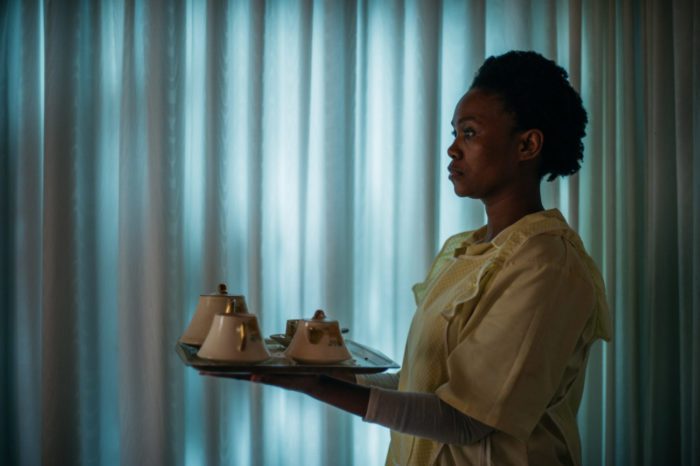By the time I had finished watching Jenna Canto Bass’s Good Madam, I almost immediately knew I had to watch it again. Partially, to try and further understand what I had just seen—I am, after all, a white American guy, somewhat alien to both life in post-apartheid South Africa and the more universal issue of Black oppression wherever and whenever it rears its head, and even after repeated viewings I’m sure some of the film’s context and themes are still lost on me. But, mostly I just wanted to watch the film again. And again. And again. Good Madam is slow-burn horror done to near perfection, the kind that slowly creeps under your skin and lingers there long after the final image has left the screen. It blends family drama, historical horror, and twisted mythology into one of the most unsettling haunted house films I’ve seen all year, complete with some singularly disturbing imagery and sound design and culminating in a “what-the-hell-did-I-just-watch” ending that will no doubt haunt me for quite some time.
Good Madam, set in one of the wealthy white neighborhoods of South Africa, is effectively the story of three generations of South African women: Tsidi (Chumisa Cosa), her daughter Winnie (Kamvalethu Jonas Raziya), and her estranged mother, Mavis (Nosipho Mtebe). Following a family conflict after the death of Tsidi’s grandmother, Tsidi and Winnie wind up having to stay with Mavis at the home of the wealthy white woman who Mavis has spent practically her whole life working as a live-in maid for. The conflict between their often contradictory wants drives the first half of the film: Tsidi is trying to convince her mother to leave a situation that she sees as a continuation of apartheid while also trying to protect and raise her daughter; Mavis wants to make sure that her catatonic mistress is taken care of, knowing that the trio’s living situation is dependent on her while Winnie is just happy to be living in a new house and doesn’t want to go back to their old neighborhood.
In the background of all this is the titular “Madam,” a wealthy, white, catatonic old woman named Diane. Despite hardly being seen on camera, her presence is felt throughout the entire film, whether it’s the repeated glimpses of her photograph or her ragged, strained breathing that seems to resonate throughout the whole house. Sweeping shots of her vast untouched china cabinet clash with the single cup Mavis is allowed to use, and the ringing of the handbell she uses to call for Mavis gradually becomes one of the film’s most sinister motifs as time goes on—this is her house, and one that we’re repeatedly told is a place where Tsidi and her daughter will never be fully welcome, underscored by the substantial list of house rules that Mavis reminds them of upon their arrival.
Speaking of Tsidi, she quickly falls into a role similar to that of Anthony McCoy from Nia DaCosta’s excellent Candyman sequel, digging further and further into a horrifying legacy that seems to simultaneously be pulling her deeper into the darkness of the past. As the film goes on, Tsidi seems to be increasingly in the grip of something, plagued by horrifying visions and seemingly falling into a trancelike state as she slowly loses control of herself, leading to conflicts with Winnie, her husband Luthando and her brother Stuart as she tries to get herself and Winnie away from whatever it is that haunts the house and is trying to sink itself into her.

What might be the most impressive aspect of Good Madam is the restraint shown throughout by Bass and company: the supernatural elements—allegorical to the legacy of apartheid and how it continues to shape life in South Africa to this day—are critical to the story, but they’re never employed in a way that overwhelms it or takes our focus off our characters and the struggles they face. The few scenes where things get nasty are done in a way that never feels shocking or gratuitous, and the film’s relatively small and confined set is utilized in a way that feels utterly claustrophobic. Shots and motifs are repeated again and again to mesmerizing effect: unsettlingly close shots of Mavis’ domestic work, repeated glimpses of the photographs of the house’s previous “workers” and various pieces of artwork, drawings, and Egyptian hieroglyphics all combine to create a deep sense of unease that never fully leaves us, even in the film’s quieter moments.
What’s astonishing is that this film doesn’t feel any less scary for the amount of restraint shown—in fact, Good Madam contains some of the most genuinely disturbing shots that I’ve seen in any film in recent memory. Details that seem mundane become more unsettling each time we pass over them, and almost every shot feels essential to both the message Bass and company want to send and the discomfort felt throughout the entire film. Even the film’s language, switching between Isixhosa and English, is utilized to jarring effect at crucial moments.
Similar to the aforementioned Candyman and the filmography of Jordan Peele, Good Madam is a film squarely aimed at a very specific, horrifying slice of history. The very phrase “good madam” feels contradictory by nature: no matter how good Diane might treat Mavis, she’s still participating in a system that keeps her live-in maid in what amounts to slavery and this contradiction is something Good Madam meets head-on. Mavis might have worked for Diane for almost her entire life, even helping to raise her children. Yet, she’s still only allowed a relatively small room in the house as others sit empty, only allowed that single cup to use while surrounded by cabinets of dishes that remain off limits.
When we finally get to the woods behind the house and find the gravestones of former workers back there—all of whom conveniently died on the exact same day as whoever they worked for—the phrases on those graves are both sinister and almost mocking: “trusted friend,” “beloved,” “our second mother,” emphasizing how a false sense of family is used to try and diminish the toxicity of these sorts of maid/madam relationships. Meanwhile, imagery from the past bleeds into the modern day, reminding us that the past is only ever a little ways away—if there’s any real difference between then and now at all. It will feel somewhat familiar to Peele fans, but Bass tells her story in a voice that feels entirely unique to her and her cast, most of whom are credited as writers as well.
But truth be told, I’ve only begun to scratch the surface of Good Madam and its themes—there’s so much I don’t want to give away that you need to see for yourself. Needless to say, it’s a film that thoroughly impressed me from start to finish and has placed itself firmly in my top five horror films of the year. Good Madam is set to arrive on Shudder on July 15th, and when it does, you’ll find a slow burner of a horror film more than deserving of your time—and your attention.



